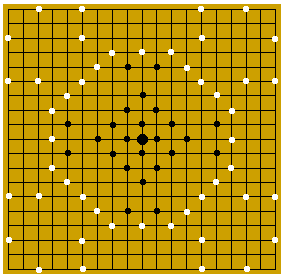
Then in his turn bold Finn also met death by the sword in his own home, when Guthlaf and Oslaf had complained of the grim attack after the sea voyage, blamed it for many woes, and the restless spirit in the heart could forbear no longer. Then the hall was reddened with the life's blood of enemies...I have indicated elsewhere in these pages that I regard the games of a people as a microcosm of their culture; or, at least, facets of their culture. Seldom have I felt this idea to have greater application than in the tafl games, for they reflect a salient feature of warfare as it was practiced in northern Europe, prior to the 11th century.from Beowulf, translated by Constance B Hieatt
Consider a king, or chieftan, as he sits in his hall, surrounded by his thanes. His enemies gather in secret, and in numbers sufficient to overwhelm the king's standing forces in a lightning raid (viking warriors were also farmers through much of the year; men could not remain under arms indefinitely; they had homsteads to manage, flocks to tend, and fields to sow and harvest). They gather around the king's hall and set it alight, forcing the defenders to fight in the open or burn in the hall. If the king can, by some desperate stratagem, break free and escape the trap, he can rally his people and strike back at his enemies. If not, he dies. Deeds of this sort are recounted in countless stories, including the best known of the Icelandic sagas: Njal's Saga.
Njal was beset by his enemy, Flosi, who had come against his hall with a hundred men. Njal ordered his people inside, to guard the doors. His sons objected:
"...these people will not hesitate to use fire if they can not overcome us in any other way, for they will resort to any means to destroy us. They will assume, and quite rightly, that it will cost them their lives if we escape..."So spoke Skarp-Hedin Njalsson, but his father would not listen, and his sons and retainers obeyed his orders. This pleased Flosi, for even greatly outnumbering his foe, he was not sure of overcoming Njal and his men in the open.
"...Now they are doomed, for they have gone indoors. We shall advance on the house at once and form up around the doors to make sure that not one of them escapes..."
 And so we come to the game tafl, which is a nearly perfect model of this sort of conflict. The word tafl itself means "a game". It is described in the sagas, and was exported abroad in various guises. In Wales it was known as tawlbwrdd, literally "throw-board", which may mean dice were involved in the game. In Ireland the game was fithcheall. And in Saxon England, where the rules were best preserved, the game was called hnefetafl. The board measures 19 x 19 grid lines, and the pieces are played at the points of the intersections (this is curiously analogous to the oriental game of go, which uses the same number of grid lines and where play also occurs at the intersections. Except for these points, however, the games are not at all alike...still, it is an interesting coincidence). The rules of play are the same as for tablut (save that the attackers may not pass through the central point) so I will not reiterate them here. The opposing forces are unequal in size, and have different objectives. The attackers attempt to trap the king in his hall, while the defenders try to open an escape route for the king.
And so we come to the game tafl, which is a nearly perfect model of this sort of conflict. The word tafl itself means "a game". It is described in the sagas, and was exported abroad in various guises. In Wales it was known as tawlbwrdd, literally "throw-board", which may mean dice were involved in the game. In Ireland the game was fithcheall. And in Saxon England, where the rules were best preserved, the game was called hnefetafl. The board measures 19 x 19 grid lines, and the pieces are played at the points of the intersections (this is curiously analogous to the oriental game of go, which uses the same number of grid lines and where play also occurs at the intersections. Except for these points, however, the games are not at all alike...still, it is an interesting coincidence). The rules of play are the same as for tablut (save that the attackers may not pass through the central point) so I will not reiterate them here. The opposing forces are unequal in size, and have different objectives. The attackers attempt to trap the king in his hall, while the defenders try to open an escape route for the king.Variants of the game abound. "Fox and Geese" (hala-tafl; literally, the Fox Game) pit a single fox against a gaggle of 13 geese (17 in a later version) on a cross-shaped grid. The fox tries to destroy the geese, while the geese attempt to hem the fox in so that he can not move. A modification of this game spread with the British to India, where during the Great Mutiny the game became known as "Officers and Sepoys". In this game, two officers in a fort attempt to hold off 24 sepoys, who must storm the fort.
NB - the quotations from Njal's Saga come from the Penguin Edition, translated by Magnus Magnusson and Hermann Palsson.